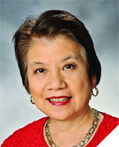A Year of Partnerships and Scientific Advancement
The American Chemical Society (ACS) had many notable achievements in 2013. This Annual Report highlights many of those accomplishments that serve our members and the broader scientific enterprise worldwide.
ACS President Marinda Li Wu’s presidential theme -- Partners for Progress & Prosperity -- brought together a multitude of efforts to help ACS members advance their careers, build alliances between ACS and related societies worldwide, and promote the global practice of chemistry. President Wu and ACS believe that, as scientists and citizens of the same planet, we have both an opportunity and a social responsibility to work together on solving global challenges through chemistry.
A major effort in support of the theme was President Wu’s Task Force Vision 2025: Helping ACS Members Thrive in the Global Chemistry Enterprise, which issued its final report and resulted in a number of follow-up activities in 2013 to strengthen member careers and enhance the global dimension of the ACS. The International Employment Initiative is one example. An ACS Symposium Book called “Vision 2025: How to Succeed in the Global Chemistry Enterprise” is now available online with more details.
Through its Publications Division, Chemical Abstracts Service, National Meeting programs, and the Petroleum Research Fund, ACS continues to be the most authoritative, comprehensive, and indispensable provider of chemistry-related information.
ACS Publications continues to expand its information offerings and published more than 39,000 articles across its portfolio of 44 peer-reviewed journals, 2.5 percent more than 2012. Our readers downloaded 83 million articles, and authors worldwide cited ACS journals more than 2.2 million times, an all-time high.
ACS journals are available worldwide in online and mobile formats, as well as in print. ACS Publications also publishes Chemical & Engineering News (C&EN – the Society’s flagship news periodical covering the global chemical enterprise and related sciences. In 2013, C&EN celebrated 90 years of continuous publication since 1923.
ACS ChemWorx, a new research management service, was introduced in 2013. It combines reference discovery and management, professional networking, group and task management, and manuscript preparation in a single interface, accessible from anywhere.
At the end of 2013 ACS Publications announced a multi-pronged strategy to position ACS as an open access publisher. It comprises 4 components: 1) ACS Central Science, a new journal that will be free to both readers and authors; 2) ACS Editors’ Choice, designed to provide free public access to new research of importance to the global research community; 3) ACS Author Rewards, a loyalty program intended to encourage ACS authors to choose open access, via $60 million in open access publishing credits redeemable over the period 2015-2017 and 4) ACS AuthorChoice, expanded in 2014 to include new and affordable licensing options to help authors meet open access requirements. The “ACS is Open” initiative is being promoted widely during 2013-2014.
The CAS REGISTRY℠ is the world’s largest collection of chemical substance information. In November 2013, CAS celebrated registration of the 75 millionth substance.
The Chemical Abstracts Service added more than 1.5 million patents, journal articles and other disclosed research sources to its databases, for a new total of more than 38 million records. Updated daily, the CAS reaction database saw even greater gains, with growth exceeding 8 million new reactions, bringing the total to 70 million reactions now available to researchers.
The ACS Membership & Scientific Advancement Division (M&SA) partnered with CAS and Washington IT to launch a new SciFinder® benefit exclusively for ACS members. This major new member benefit allows 25 complimentary SciFinder activities for personal use, using the world’s largest and most reliable chemistry-related databases through a single interface. This new benefit provides access to references from 63 patent authorities and more than 10,000 active scientific journals. More than 12,000 members have signed up for this valuable new member benefit.
The Society held two national meetings, which together attracted more than 19,000 papers and 26,000 participants. ACS also held eight regional meetings in 2013, drawing more than 3,600 papers and a combined attendance of nearly 6,000. To attract more students, M&SA developed a special “Fueled by ACS” campaign to help defer fuel costs, which earned ACS top awards in the 2013 Association TRENDS All-Media Contest.
At the 2013 ACS National Meetings, the prestigious and well-received Kavli Foundation Lectures continued to grow. ACS worked with The Kavli Foundation to establish a new Kavli-sponsored lecture series for 2013-2015 titled “Emerging Leader in Chemistry Lecture,” which identifies and acknowledges outstanding young scientists with exceptional individual achievements in scientific or engineering research. This new series was launched in 2013 at the ACS National Meeting in New Orleans.
The Petroleum Research Fund provided more than $18 million to support 198 grants in fundamental research and advanced education in petroleum and related fields.
The ACS Board of Directors approved establishing the American Association of Chemistry Teachers™, which will provide K-12 teachers of chemistry with a professional home and access to specialized resources and the broader ACS community. The Association will launch in September 2014.
The uneven recovery of the global economy since the Great Recession and a divided federal government continued to seriously affect the chemistry enterprise. Job growth remained sluggish, and industrial layoffs in chemistry-related sectors continued.
However, ACS still ended 2013 with a positive net from core operations for the tenth consecutive year. You can review the Society’s financial statements here.
As the ACS Board of Directors looks forward it will be guided by the ACS Strategic Plan for 2014 and Beyond. The plan has four strategic goals that will lead us to achieve our Vision, Improving people’s lives through the transforming power of chemistry.
ACS is the focal point for chemical professionals around the world to meet, share information, and find tools and guidance that enable them to become stronger and more marketable scientists.
We have developed innovative programs and made resources available to our global colleagues as our members’ needs have changed. We are committed to offering career and leadership training and resources, fostering international collaboration, improving chemistry education, especially providing opportunities for underrepresented populations, and engaging the general public to highlight the value and contributions of chemists and the chemistry enterprise to society. We believe that these efforts on behalf of our more than 161,000 members provide enormous benefits now and in the future.
With a solid record of achievement in 2013, it is clear why ACS is the “professional home” for chemists and chemical engineers.

Marinda Li Wu
President

William F. Carroll, Jr.
Chair
Director-At-Large

Madeleine Jacobs
Executive Director
& CEO
